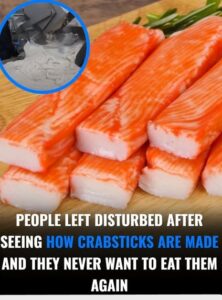The Hidden Reality Behind How Crabsticks Are Really Made

Most people love the sweetness and soft texture of crabsticks — especially in sushi, salads, or as a quick seafood snack. They look like crab, they’re shaped like crab… but a viral behind-the-scenes video recently revealed what goes into making them. And let’s just say, the internet didn’t take it well.
If you’ve ever enjoyed these imitation treats, prepare yourself. Once you see how they’re created, it’s hard to forget.
What’s Actually Inside Crabsticks?
The first surprise hits hard: there is almost never any real crab in crabsticks.
Instead, the process starts with blocks of frozen white fish, usually Alaskan pollock — inexpensive and extremely common.
The fish gets thawed and fed into huge industrial grinders, where it’s turned into a pale, sticky paste called surimi. In Japanese cooking, surimi has been used for centuries, but the industrial version looks nothing like traditional preparation.
Factories mix this paste with starch, egg whites, seasonings, and binders, gradually turning it into a thick, marshmallow-like foam. The transformation is… not pretty.
How the “Crab” Look Is Manufactured
From there, the mixture is pressed into thin sheets, layered to mimic the stringy pull of real crab meat, and then wrapped in a painted-on orange coating. That bright red “crab shell” exterior? Pure food coloring.
By the time crabsticks hit grocery shelves, they’re visually convincing — but it’s all an illusion built from reprocessed fish and dyes.
The Viral Video That Sparked Outrage
When footage of the production process made its way to social media, users reacted instantly:
-
“I’m DONE eating this. Never again.”
-
“That grey paste made my stomach turn.”
-
“I feel betrayed… like finding out Santa isn’t real.”
People couldn’t look away from the spongy grey mixture, the mechanical rollers, and the bright paint-like coating. For many, the childhood comfort food suddenly felt like a factory trick.
Is It Really That Bad?
Not everyone was horrified. Some compared crabsticks to hot dogs, chicken nuggets, or deli meat — all foods made through industrial processing.
“If you eat processed food, you already know the deal,” one person wrote.
Another added, “I’ll still eat them. They taste good. I don’t need to pretend they’re real crab.”
This raises the bigger question:
Are we upset because the food is bad, or because the truth breaks the illusion?
Why Imitation Crab Exists at All
Real crab is costly, seasonal, and difficult to harvest. Surimi allows companies to make a cheaper alternative that’s accessible year-round.
Flavor enhancers like MSG, sugar, salt, and fish extracts give the final product its “crab-like” taste. Without them, it would taste like bland rubber. With them, it tastes familiar enough to fool almost anyone.
Safe? Yes. Appetizing? That’s Another Story.
Food safety isn’t the issue — imitation crab is regulated and considered safe to eat.
What unsettles people is seeing the production process. Once the visual illusion fades, it’s hard to pretend the brightly colored sticks came straight from the ocean.
For some, that knowledge ruins the fun. For others, it changes nothing.
Does This Mean You Should Stop Eating Crabsticks?
That depends on what matters to you.
If convenience and flavor count more than purity, imitation crab is harmless.
But if you prefer whole foods and transparency, this might make you rethink your next California roll.
Sometimes new information makes us rethink our choices.
Other times… we take another bite and move on.